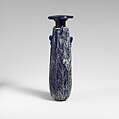Glass alabastron (perfume bottle)
Eastern Mediterranean or Italian
Translucent cobalt blue, with handles in same color; trails in opaque yellow, opaque white, and opaque turquoise blue.
Broad slightly uneven rim-disk, made as a spiral coil around top of neck; cylindrical neck, tapering downwards; narrow angular shoulder; straight-sided cylindrical body, with slight upward taper; convex lop-sided bottom; on upper body, two vertical ring handles, with short pointed trails, applied over trail pattern, one slightly higher than the other.
A yellow trail attached at edge of rim-disk; on body, alternating bands of yellow, white, and turquoise blue, tooled from top of body to undercurve at bottom into a close-set feather pattern in nine vertical panels with alternating upward and downward strokes, forming large round loops at bottom.
Broken and repaired around body, with three large holes and several smaller cracks and chips; most of trails completely weathered, leaving hollow lines in body; slight dulling, faint iridescent weathering, and some deep pitting.
Among the more striking examples of glass perfume vessels of the fourth century B.C. are tall, large-bodied alabastra in dark grounds with applied threads combed into zigzag, feather, or festoon patterns over the body.
Due to rights restrictions, this image cannot be enlarged, viewed at full screen, or downloaded.

